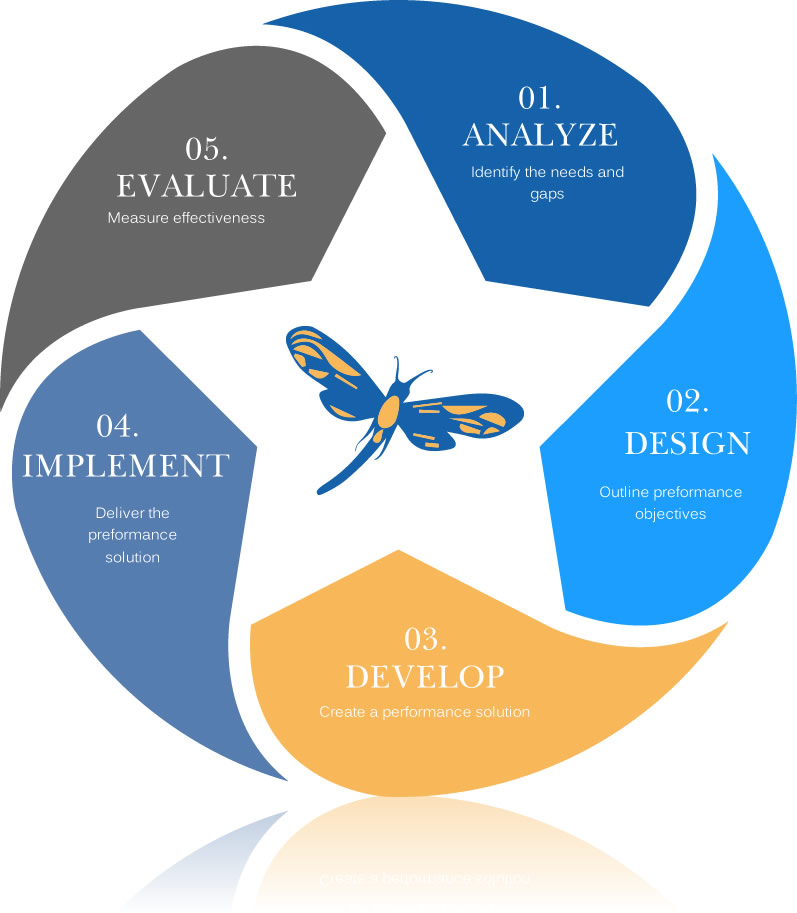Corporate Training: Designing Instructionally Sound Learning that Works
Applying a variety of proven industry models allows for consistency and flexibility. The ADDIE model (seen below) is a proven model as a standard for curriculum development. Other models exist like SAM and AGILE and are quite reliable and should be mentioned here as well. The objective is to provide solutions that maximize business return on investment (ROI).
Training is NOT a lecture. Phillip’s approach is to create a safe environment and apply the latest laser-focused accelerated learning techniques to deliver a program that is highly interactive and edutaining (educational and entertaining). Do not plan to sit in one place very long in one of Phillip’s programs.
Solid training always begins with a thorough analysis. Regardless, it if is facilitated learning or designing curriculum involves solid analysis of the needs and understanding of expectations. Facilitating programs requires analysis of the audience, site for the program and specific learning objectives. Every program is customized.
This analysis and customization ensures the organization is able to maximize its ROI and achieve sustainable results. Often training is necessary to create a shift in behavior. These shifts often have an impact and therefore must align with the culture of the organization.
Corporate learning programs that allow for self-discovery and leverage a blended approach (self-paced asynchronous and classroom synchronous) are often the most successful. Creating a shift in behavior means we often need to create new habits. This typically takes weeks. Therefore, an emphasis on post-classroom learning strategy is imperative, otherwise, conversations disappear. This will support application of the learning experience on the job after the class.
YOUR PROGRAM DESIGN AND CUSTOMIZATION PROCESS: ADDIE MODE

01: Analyze
This is the foundation Phillip will rely upon to provide you an effective and sustainable solution. The instructional challenge(s) of the course is detailed, objectives are established and issues such as participant skill level are identified. The emphasis is to identify what the participants need to know to achieve the desired outcomes.
02. Design
During this phase, Phillip will focus on many considerations to achieve effective and deliberate curriculum design and customization. These will include learning objectives, content, assessment and evaluation tools, interactive exercises, subject matter feedback, segment chunking and media variety. Each is leveraged in a logical and instructionally sound method to achieve retention, application and the instructional goals.
03. Develop
As a curriculum designer and developer, Phillip will create the content following a design roadmap. This often includes storyboards and graphics, as well as integration of any eLearning and social learning tools.
04. Implement
This phase focuses on developing procedures for training both facilitators and learners. Facilitators training, train-the-trainer (T3) should explain the curriculum, learning outcomes, method of delivery and testing procedures. Participant preparation includes training the use of new software and hardware, and registration. Preparation of learning materials including workbooks, job aids, and other tools are tested.
05. Evaluate
Effective evaluation will occur throughout ADDIE process. Phillip relies on this to ensure all the learning experience aligns to support organizational needs and established learning objectives. It is important to also identify what on-the-job performance should look like after completion of the learning experience, to ensure business needs are achieved.



